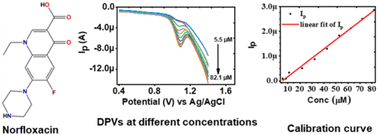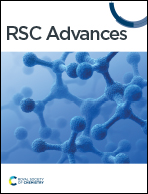A CaCuSi4O10/GCE electrochemical sensor for detection of norfloxacin in pharmaceutical formulations†
Abstract
This study reports on a calcium copper tetrasilicate (CaCuSi4O10)/glassy carbon electrode (GCE) electrochemical sensor developed for rapid sensing and quantification of an antibacterial drug, norfloxacin, using both cyclic voltammetry and differential pulse voltammetry. The sensor was fabricated by modifying a glassy carbon electrode with the CaCuSi4O10. Electrochemical impedance spectroscopy was performed and the Nyquist plot showed that the CaCuSi4O10/GCE had a lower charge transfer resistance of 22.1 Ω cm2 compared to the GCE with a charge transfer resistance of 43.5 Ω cm2. Differential pulse voltammetry showed that the optimum pH for the electrochemical detection of norfloxacin in potassium phosphate buffer solution (PBS) electrolyte was pH 4.5 and an irreversible oxidative peak was found at 1.067 V. Two linear ranges were established at 0.01 to 0.55 μM and 0.55 μM to 82.1 μM, and the limit of detection was ca. 0.0046 μM. We further demonstrated that the electrochemical oxidation was controlled by both diffusion and adsorption processes. The sensor was investigated in the presence of interferents and was found to be selective toward norfloxacin. The pharmaceutical drug analysis was done to establish method reliability and a significantly low standard deviation of 2.3% was achieved. The results suggest that the sensor can be applied in the detection of norfloxacin.



 Please wait while we load your content...
Please wait while we load your content...